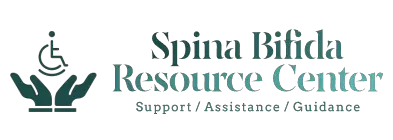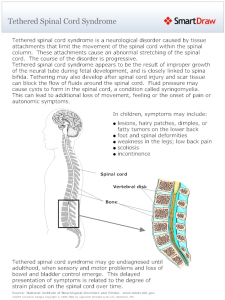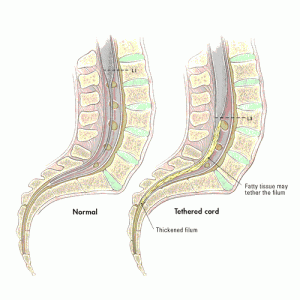Introduction
The spinal cord is the collection of nerves that carries messages between the brain and the body. When a baby is born, the spinal cord is the same size as the spinal column. The bones of the back around spinal cord are called the spinal column. With the growth of a baby, the spinal column grows longer than the spinal cord. This is why, the spinal cord moves freely inside the spinal column. But in some children, a part of the spinal cord is “tethered” or attached to a part of the spinal column and the spinal cord can’t move freely. This is called tethered cord.
As the child grows, the spinal cord is stretched due to the tethered part. Stretched nerves may not work properly, and this causes problems for the child.
Tethered spinal cord is a neurological disorder. This condition is difficult to diagnose because of its non-specific symptoms. Normally the spinal cord moves freely in the spinal column but in this condition, the spinal cord is stuck to another structure in the spine, such as, scar tissue due to an operation, to a bony structure or even the presence of a tumor. This condition affects spinal cords growth and its functional ability. It affects people of all ages, especially infants and young children. Most often, it is associated with congenital conditions like spina bifida and chiari syndrome. Although its proper treatment can result in complete recovery, the problem is that, most often, it is under-diagnosed or misdiagnosed.
Figure 1. Diagram (Source: wc1.smartdraw.com)
Causes
Following is a list of causes:
- Spina bifida
- Chiari syndrome
- Split spinal cord
- Lipoma (a benign, fatty growth)
- Tumor
- A spine trauma
- Spine surgery
Symptoms
Symptoms are age-dependent.
- Adult children can experience pain in their back, leg, weakness in the lower extremities and fatigue while walking.
- Bladder infections, urinary or fecal incontinence or retention, as well as, urinary hesitancy and urgency can be the symptoms of this condition.
- Babies and infants may exhibit delayed motor functions, such as, late walking.
- Dark or red spots or lesions, hairy or soft masses can be present on the back.
- They may show symptoms like scoliosis.
- Differences in the size of the legs or feet, and foot deformities are also seen.
- Patient may exhibit deterioration in gait.
- Patient may show skin discoloration.
Patients with untreated tethered cord will continue experiencing their symptoms, and these symptoms may worsen with the passage of time. Particularly in children, untreated tethered spinal cord may lead to paraplegia due to growth of spinal cord and loss of bowel and bladder function. Paraplegia is the condition when the affected baby cannot move his/her all four limbs. Chronic pain in legs and back of children is not common and should not be taken lightly. (https://picklelicious.com/)
Diagnosis
It can be diagnosed by conducting or getting help from the following tests or investigations:
- Spinal Magnetic resonance imaging (MRI)
- Ultrasound
- Computed tomography scan (CT scan)
- Myleogram (an x-ray of the spinal canal)
Treatment
It can be treated or managed as mentioned below:
- Most often, this condition is treated by surgery. This is done to prevent the chances of neurologic deterioration. An operating microscope is used during surgery. The tethered structure is moved away from the spinal cord. However, it is necessary to kept in mind that the tethered structure should be removed because if the structure is bony or tumor, it can cause re-tethering of the spinal cord. Mostly, patients regain normal functioning ability after surgery.
- Physical therapy may also help with managing the physical problems of a tethered spinal cord.
Medication
Tethered spinal cord is not treated with medication. However, for some children, pain due to this condition can be managed with one or more of the following types of medication:
- Analgesics (painkillers): these drugs relieve pain.
- Muscle relaxants: these drugs prevent painful spasms of muscles by suppressing the contractions. Also, medications may be helpful for bladder incontinence.
Figure 2. Differences Diagram
Surgery
Surgery is generally performed only if there are clinical signs of deterioration. Studies reveal that surgical release of tethered cord in infants improve neurological, bowel and urological functions [1]. The surgery begins by opening the skin over the tethered area. The myelomeningocele or bony vertebrae are removed to get better exposure of the spinal cord. The covering is then opened, and the spinal cord or other abnormalities are dissected away. Once the tethered structure is separated from all of its attachments, the coverings on the back are closed.
The patient can show normal functioning ability within a few weeks. Recovery depends upon the degree of preoperative clinical deterioration. Following are complications that may happen to occur after surgery:
- Infection
- Bleeding
- Decreased muscle strength or bladder or bowel function due to damage to the spinal cord or myelomeningocele
Many children require only one surgery. Usually, children improve or at least stabilize their level of functioning. However, there is a chance for the spinal cord to re-tether as the child gets older and for this reason it is important that they should be carefully monitored as re-tethering may occur during the growth period. Ten to 20 percent of the patients with this disability require more than one surgery.
Figure 3. Surgery images for tethered spinal cord (Source: www.pediatricneurosurgery.org)
Positive and negative aspects of Surgery
The good news is that tethered cord is a treatable condition, especially when diagnosed early in the child’s life. Surgery is the only treatment for this condition. Although surgery might not restore the functioning ability of damaged and deteriorated nerves it can stop further damage. Children may have normal life after treatment.
Spinal nerves are not for just one function. They receive messages from the body and send them to brain. So, the damage to the spinal cord may affect many other functions in the body.
Key points
- Tethered cord means that the spinal cord cannot move freely inside the spinal column. The spinal cord is stretched.
- This condition can cause problems with bladder control, bowel control, or walking.
- This may be treated only with surgery.
References
1. Bowman RM, Mohan A, Ito J, Seibly JM, McLone DG. Tethered cord release: a long-term study in 114 patients. J Neurosurg Pediatr. 2009;3(3):181-7.
2. Mishra SS, Panigrahi S, Dhir MK, Parida DK. Tethered cord syndrome in adolescents: Report of two cases and review of literature. J Pediatr Neurosci. 2013 Jan-Apr; 8(1): 55–58.





